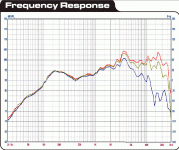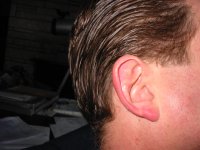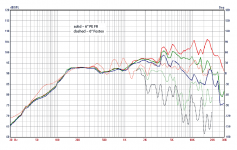Dayton PS180-8 6-1/2" Point Source Full-Range Neo Driver | Parts-Express.com
Thoughts? Looks nice, if nothing else.
Thoughts? Looks nice, if nothing else.
There is also an 8" but i can't open the pdf file to see it's frequency response. The 6.5" fr looks yucky... but i wonder how these will sound. Kevlar... grrrrrr.
Likewise.
They strike me to have been designed to look impressive: they've got the fancy connectors & phase plug, neo. motor, big cast metal frame, kevlar in the cone material etc. which all make good marketing copy. Whether they are actually of any use in performance terms is another matter entirely though. The cone profile looks fairly deep, & for a driver that is claimed to possess a smooth response, it doesn't appear to be anything to write home about. Still, like Dave & Jeff I won't write them off purely on the strength of the published data; they may perform decently in practice. But given the current evidence, investigating them is a long way down my 'to do' list.
They strike me to have been designed to look impressive: they've got the fancy connectors & phase plug, neo. motor, big cast metal frame, kevlar in the cone material etc. which all make good marketing copy. Whether they are actually of any use in performance terms is another matter entirely though. The cone profile looks fairly deep, & for a driver that is claimed to possess a smooth response, it doesn't appear to be anything to write home about. Still, like Dave & Jeff I won't write them off purely on the strength of the published data; they may perform decently in practice. But given the current evidence, investigating them is a long way down my 'to do' list.
Last edited:
There is also an 8" but i can't open the pdf file to see it's frequency response.
I looked at the response chart last night. Lets just say the specs on the PE website seem skewed a bit. It has a very sharp drop at 150Hz. Theres also a huge peak between 2.5 and 5Khz. On-axis response looks nice, but off-axis is a whole different story. Looks like a very large drop after 5KHz off-axis. I wonder how it would be had they used paper and not kevlar.
Last edited:
I've held them in my hands but not heard them. The certainly do look well built.
The Klippel testing is supposed to have gone very well.
The Klippel testing is supposed to have gone very well.
So did the testing for the Peugeot 207, but you wouldn't want to own one of those either would you? 😛 😀
Goodness knows, re the paper & paper / kevlar combination. Depends on what you call paper, as there are a vast number of possible papers / paper variations available, so the breakup & micro-resonant behaviour for a given cone profile & material thickness vary dramatically depending on exactly what type is employed. That said, I'm not a fan of kevlar generally, for cones or anything else for that matter.
Goodness knows, re the paper & paper / kevlar combination. Depends on what you call paper, as there are a vast number of possible papers / paper variations available, so the breakup & micro-resonant behaviour for a given cone profile & material thickness vary dramatically depending on exactly what type is employed. That said, I'm not a fan of kevlar generally, for cones or anything else for that matter.
Last edited:
No, but a Peugeot 202 I would love!
Will be interesting once these drivers get out into nature. Let folks work with them and report back. I will not be guessing on the results. 🙂
Will be interesting once these drivers get out into nature. Let folks work with them and report back. I will not be guessing on the results. 🙂
All large diameter full range drivers are going to have less than ideal response off axis, even whizzer cone and phase plug equipped models. Most designs show a rising response on axis which when averaged with 15 and 30 degrees off, becomes a fairly flat response. I commend Dayton for at least having the guts to publish off axis charts. I can only say that in my experience, Dayton's measurements are very accurate.
Cone material by itself has little to do with a speakers performance. It's the implementation of the material inot the overall design that matters most. Each material has a characteristic, nothing more.
A full range driver with accurate measurments showing off axis performance and PUBLISHED Klippel tests. Sounds like the dealer is showing the deck here instead of flipping the turn card AFTER you've paid for it......and that's a gamble. As for most of the fullrange summations and designs i've seen posted about, little to none have any measurements to back up the subjective rants that often follow.
Looking in from the multi-way side of things, it often appears that the Fullrange crowd is claiming some kind of 'Magic' in these designs cluded in mystery that must be 'heard' to understand. Why is that? Why can't i and others 'see' these claims in electro-analysis. Is there some secret property these drivers and designs exhibit that can't be measured. Are there Z particles at work here?
No, of course not. Anything shrowded in mystery is usually presented that way as it defies the scientific results and what we physically know about the propogation of sound waves.
To the fullrange guys.....you've been shown a driver with a full measurement analysis instead of smoke and mirrors. Instead of hiding the MoJo of fullrangers behind a blanket of subjective listening properties, make us multi way guys believe!...show us the measurements that these designs are that special. By looking at the Dayton data, there's room for a great design there......as much as ANY of the other, more em.....established fullrange drivers.
As an outsider, the tone of the thread was reminiscent of a playground of neighborhood kids wondering if the new kid should be allowed to play instead of CAN he play. Certainly the Dayton can play, the measurements speak to that just as a major league pitcher's stats speak for his ability.....Unless their's 'magic' rules in fullrange sports?
Cone material by itself has little to do with a speakers performance. It's the implementation of the material inot the overall design that matters most. Each material has a characteristic, nothing more.
A full range driver with accurate measurments showing off axis performance and PUBLISHED Klippel tests. Sounds like the dealer is showing the deck here instead of flipping the turn card AFTER you've paid for it......and that's a gamble. As for most of the fullrange summations and designs i've seen posted about, little to none have any measurements to back up the subjective rants that often follow.
Looking in from the multi-way side of things, it often appears that the Fullrange crowd is claiming some kind of 'Magic' in these designs cluded in mystery that must be 'heard' to understand. Why is that? Why can't i and others 'see' these claims in electro-analysis. Is there some secret property these drivers and designs exhibit that can't be measured. Are there Z particles at work here?
No, of course not. Anything shrowded in mystery is usually presented that way as it defies the scientific results and what we physically know about the propogation of sound waves.
To the fullrange guys.....you've been shown a driver with a full measurement analysis instead of smoke and mirrors. Instead of hiding the MoJo of fullrangers behind a blanket of subjective listening properties, make us multi way guys believe!...show us the measurements that these designs are that special. By looking at the Dayton data, there's room for a great design there......as much as ANY of the other, more em.....established fullrange drivers.
As an outsider, the tone of the thread was reminiscent of a playground of neighborhood kids wondering if the new kid should be allowed to play instead of CAN he play. Certainly the Dayton can play, the measurements speak to that just as a major league pitcher's stats speak for his ability.....Unless their's 'magic' rules in fullrange sports?
>>> Looking in from the multi-way side of things, it often appears that the Fullrange crowd is claiming some kind of 'Magic' in these designs cluded in mystery that must be 'heard' to understand. Why is that? Why can't i and others 'see' these claims in electro-analysis. Is there some secret property these drivers and designs exhibit that can't be measured. Are there Z particles at work here?
Most of us on the full range forum were probably multi way guys at first.
Many full range drivers measure terribly but sound excellent. No magic... rather no crossover. For me they are similar to tube amps that measure poorly. The magic is in the midrange and that's where both excel.
Of course they have limitations as do every other speaker. But the pros outweigh the cons for many listeners and speaker builders.
I was saving up for Alpair's... who's frequency response look nearly opposite the Dayton's... but i bet they both can be made to sound really great in the right design.
I checked the measurement and it appears the 8" Dayton will fit the same odd cutout as the Tangband 1808. Maybe i will get a pair and swap them in and out... neither driver is intended for open baffle but if it sims to 200hz i may sneak a pair into the house and give a listen. But i would love to see the 8" fr first. Maybe the file will open on my pc in the office?
Zilla
Most of us on the full range forum were probably multi way guys at first.
Many full range drivers measure terribly but sound excellent. No magic... rather no crossover. For me they are similar to tube amps that measure poorly. The magic is in the midrange and that's where both excel.
Of course they have limitations as do every other speaker. But the pros outweigh the cons for many listeners and speaker builders.
I was saving up for Alpair's... who's frequency response look nearly opposite the Dayton's... but i bet they both can be made to sound really great in the right design.
I checked the measurement and it appears the 8" Dayton will fit the same odd cutout as the Tangband 1808. Maybe i will get a pair and swap them in and out... neither driver is intended for open baffle but if it sims to 200hz i may sneak a pair into the house and give a listen. But i would love to see the 8" fr first. Maybe the file will open on my pc in the office?
Zilla
Thanks GM. I think it's because my laptop is old and running an older version of Acrobat.
The plot looks fugly.
The plot looks fugly.
The plot looks fugly.
Actualy Zilla, if you look at the scale of the measurment, it actually measures better than most Fostex fullrangers of equal SD and the resolution of the graph is MUCH better than the smoothed Fostex graphs gone over with ink freehand😱 Scaling a measure to represent a more presentable performance is common practice.....and let's not even talk about accuracy or the lack of measurement condition reports where 'wacky' tecniques are used for a positive outcome yet are still 'accurate'!😀 We've heard this discussion lately haven't we.
As to other 'Boutique' FR's.....at least Dayton's giving you the off axis info, the question is why aren't they?
You have ears, too? Gosh!
(I thought the big speakers were to make up for the no ears thing)
Put a small inductor in front of that driver and it will flatten right out.
(I thought the big speakers were to make up for the no ears thing)
Put a small inductor in front of that driver and it will flatten right out.
Wonder why you can see one and not the other?
I'm having trouble with the 8" pdf... what downloads is an empty file...checked it in illustrator.
if you look at the scale of the measurment, it actually measures better than most Fostex fullrangers of equal SD and the resolution of the graph is MUCH better than the smoothed Fostex graphs gone over with ink freehand
Attached is the factory FE166En FR (dotted), overlaid the Dayton. Fostex data doesn't look any more smoothed than the Dayton.
dave
Attachments
As to other 'Boutique' FR's.....at least Dayton's giving you the off axis info, the question is why aren't they?
Probably because in the scheme of things it's irrelevant to folks committed to single driver systems or at least for using them over the majority of the audible BW where any XOs used are typically outside our acute hearing BW.
GM
- Status
- Not open for further replies.
- Home
- Loudspeakers
- Full Range
- Dayton 6.5" fullrange.


